Can you think of a better way to spend a day than making fresh pasta with friends…while in Rome? I sure can’t. And that’s why our day at the Fabiolous Cooking Day school in Rome was such a standout treat.
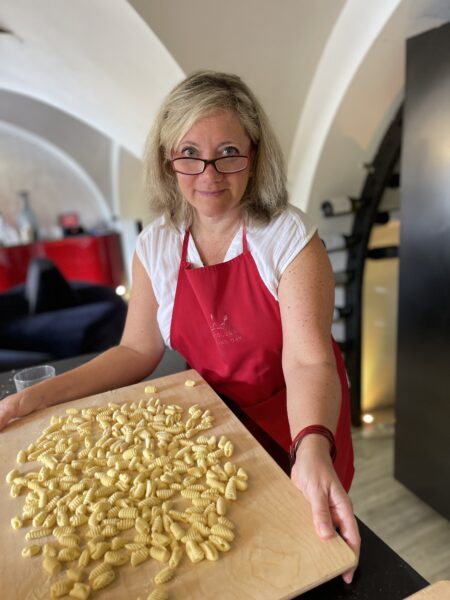
Photo credit: Dorie Greenspan
While spending a day at the school, we learned how to make three different kinds of fresh pastas. We also learned about Italian flour while absorbing all sorts of wisdom from the chefs. A key takeaway? Pasta-making is fun – and it’s even more fun in a group.
Chef Fabio and Fabiolous Cooking Day
Chef Fabio Bongianni founded the Fabiolous Cooking Day school after he realized that cooking was his passion.
He trained as a lawyer, but, as he told us, he wanted to be a part of a happier side of life. “The best part of your day is not when you call your lawyer; it’s when you eat and drink with your friends,” he said.
Bongianni told us how when he is traveling he always tries to meet some “locals.” And so when he created his cooking school, he decided he wanted to bring people into an atmosphere that felt like a home.
In fact, the cooking school is in a home – sort of. The school is in a large second-floor apartment in a historic building on the tiny island of Isola Tiberina along the Tiber River in Rome. The building is part of a square that houses a basilica and a restaurant, connected to the rest of Rome by two ancient river bridges.
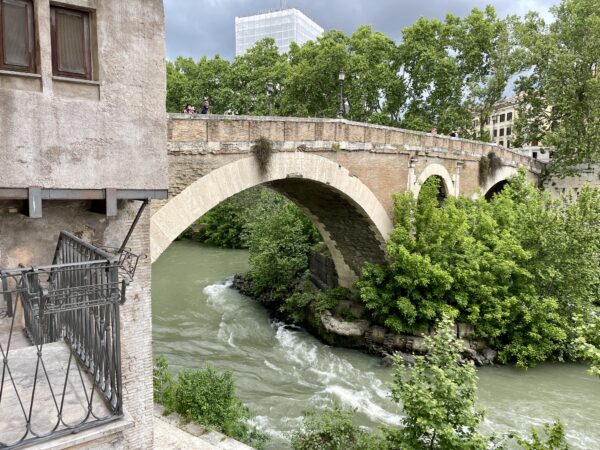
The Ponte Fabricio, crossing the Tiber River behind Fabiolous Cooking Day, is the oldest Roman bridge, built in 62 B.C.
The apartment is cozy, with barrel-vaulted ceilings and beautiful midday light. A giant kitchen opens out into a large round table with comfy chairs, inviting that day’s “chefs” to sit back and enjoy their creations.
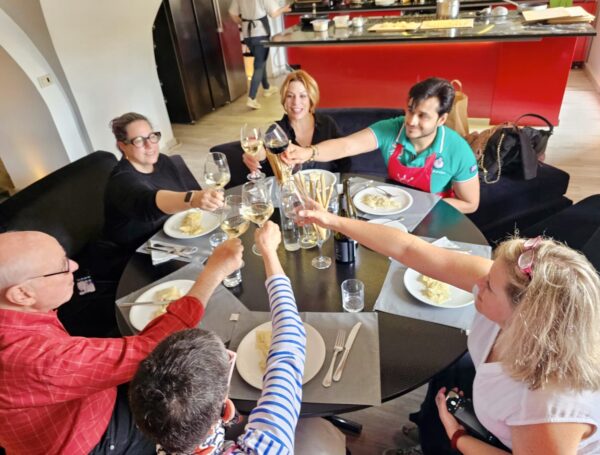

The class we took was the Pasta Making Class with Chef Monica Farcas. It was a 2 1/2 hour session (in English) that involved making three fresh pastas and then eating them at a sumptuous meal with plenty of wine.
Pasta Number One: Cavatelli
The first pasta we made was cavatelli, which is like a tiny grooved pasta dumpling. To make cavatelli, we used Italian semolina flour and water in a 2:1 ratio. For our small batches this amounted to 100 grams of semolina to 50 grams of water. (The Italian semolina flour used for pasta is a very fine grind, much finer than what is frequently sold in the U.S. as semolina flour.)
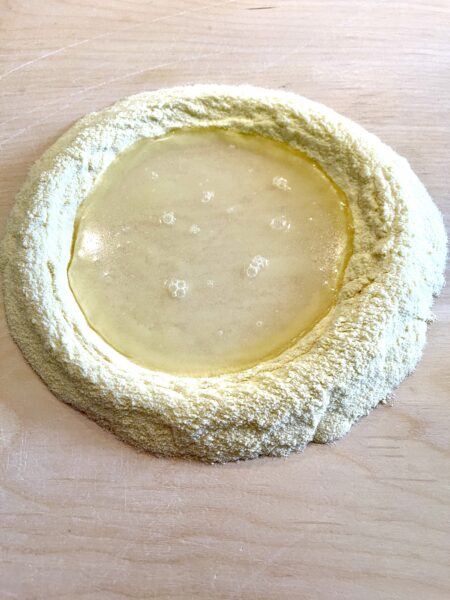
Semolina flour with a “well” of water in the center.
To make this pasta, we folded the water into the flour and made a neat ball of dough; then let it rest briefly. Then we rolled it into long strands and cut the strands into little pillows. Finally, we rolled each little pillow down a ridged wooden wedge.
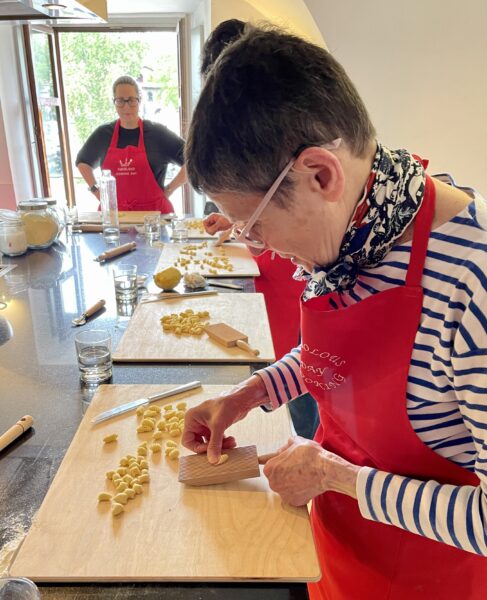
Dorie carefully rolls the cavatelli down the wooden board.
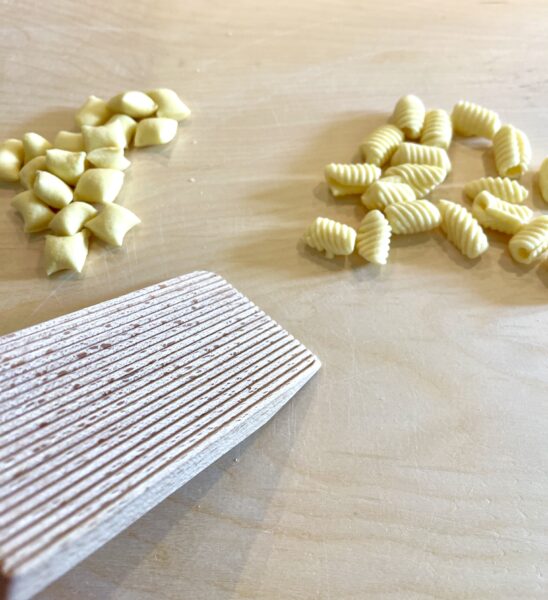
Cavatelli before and after being rolled
The result: An adorable little ridged cavatelli nugget; perfect for absorbing sauce. (By the way, fresh pasta cooks very quickly. These cavatelli cooked in about three minutes; the tagliatelle took only about two minutes.)
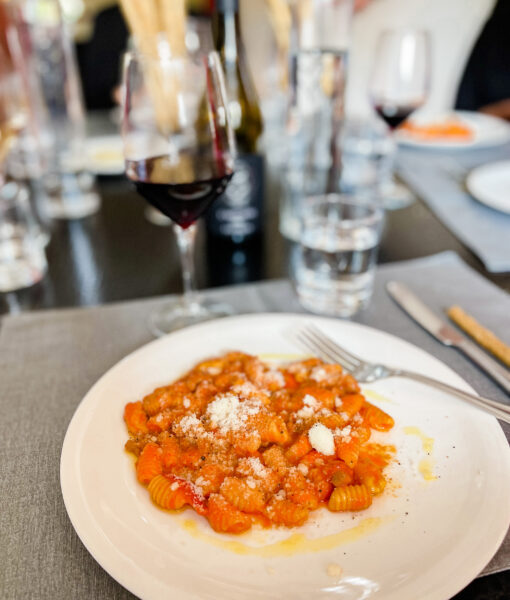
There are other ways to make cavatelli without this wooden wedge, but the wooden wedge gives it professional-looking perfect ridges. Added bonus: If you take a class at Fabiolous Cooking Day, you will get a coupon for a free wooden pasta making wedge. You can then go pick up your wedge at Chef Bongianni’s That’s Amore restaurant in the historic center of Rome, right near the Trevi Fountain.
Pasta Number Two: Ravioli
For this ravioli, we made small batches with the ratio of one egg to 100 grams of type 00 flour (extra-fine soft wheat flour). We mixed the egg in with the flour, again to make a very soft dough, then rolled it out into a long strip.
Now here’s where your friends come in. We rolled it out through the pasta maker…and it was long. Then we rolled it out through the pasta maker again…and it was extra long. And so on, and so on, until we needed several people to carry the length of the thin sheet of pasta.
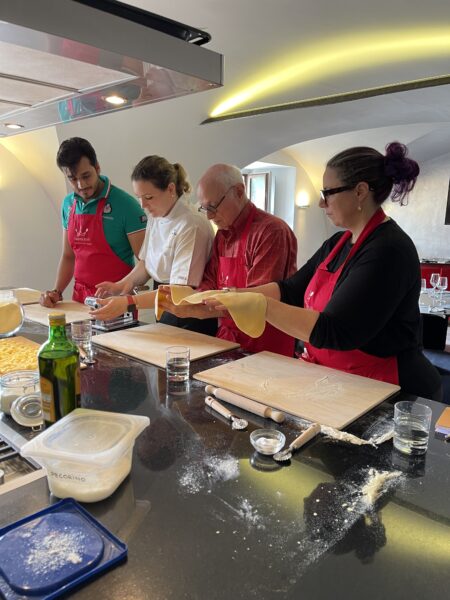
Amay, Monica, Michael, and Stacey started forming a line to hold the sheets of pasta as they came out of the machine.
We topped the ravioli with a mixture of ricotta, egg, Parmesan, and finely chopped Roman zucchini. Side note: The Roman zucchini was so interesting – it had teeny tiny ridges. We’d love to try cooking that in a bunch of different ways if we ever see it again.
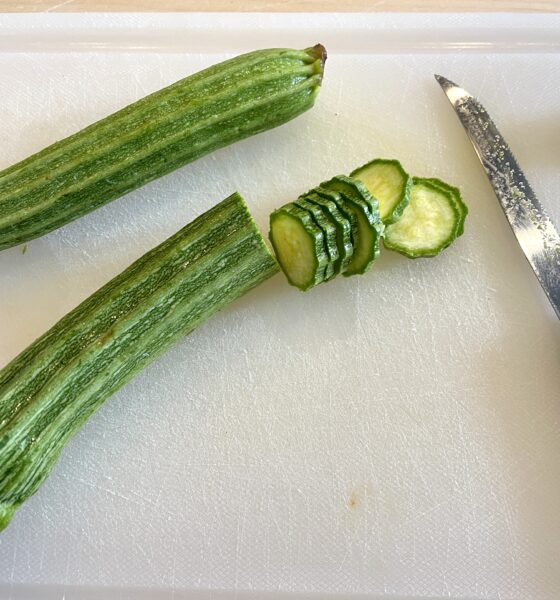
Ridged Roman zucchini
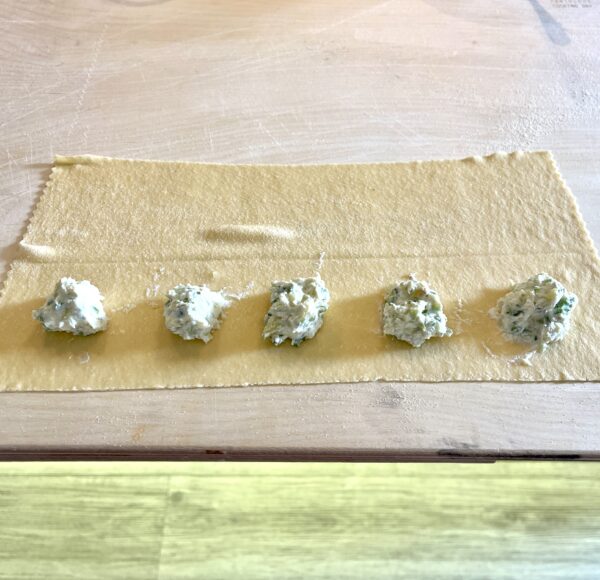
The zucchini filling waits to turn into ravioli.
Once we sealed up the ravioli, it cooked very quickly because it was so fresh. Monica served it with just a simple butter and sage sauce – perfect for bringing out the flavorful pasta and filling.
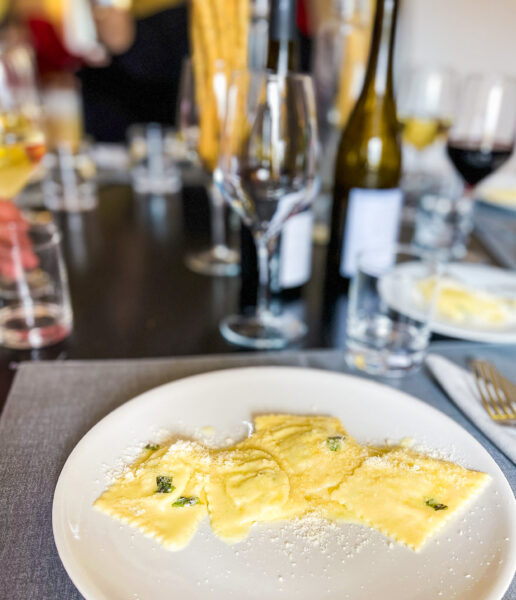
Pasta Number Three: Tagliatelle
The third pasta, tagliatelle, was super-easy to make after we accomplished the ravioli. We took the leftover thin sheets of pasta and sliced them about 1/2 inch wide to make long ribbons of pasta.
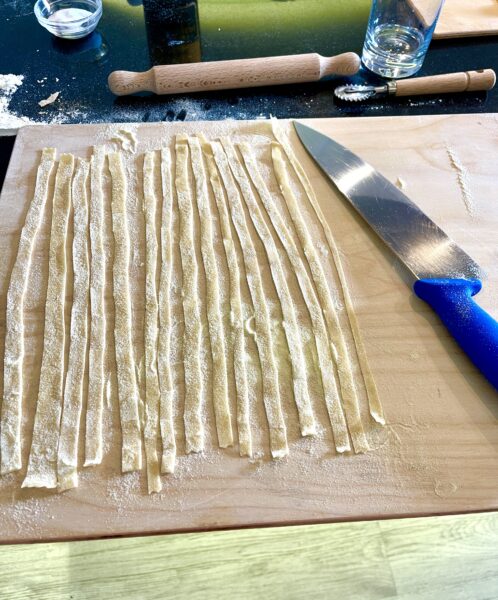
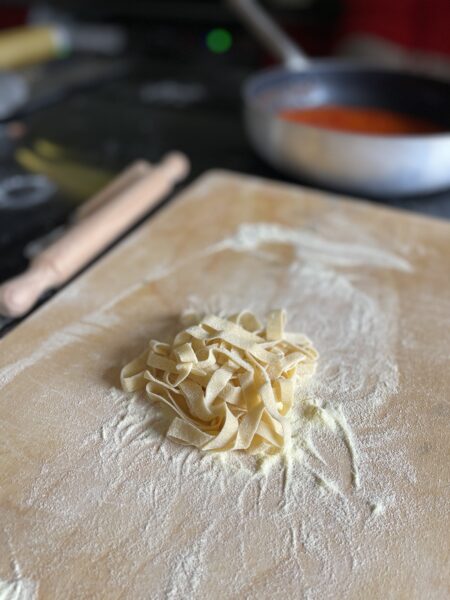
Then Chef Monica taught us how to make a beautiful cacio e pepe pasta dish. She drained the pasta, leaving a little bit of water, and then heated the pasta in a pan over a flame until the starchy pasta water evaporated. Then she made a paste with cheese and pepper along with ice-cold water. She slowly added the paste to the pasta, incorporating it little by little. Finally, she added just a bit more hot pasta water to make a creamy sauce.
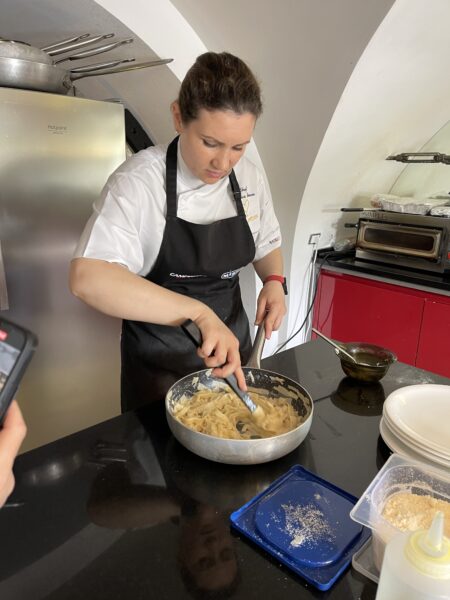
Chef Monica Farcas demonstrating how to make cacio e pepe.
(Don’t throw away the pasta water, she said. This starchy water can be extremely useful in the final stages of pasta cooking.)
The Best Flour = The Best Pasta
So what was the common theme in all of the pastas we made? The best pure flour from Europe. The European Union’s flour industry is known for its cutting-edge technology, highest safety and purity standards, and sustainable processes. Italy leads the pack, with 233 mills producing over 4 million tons of flour per year. (We had a chance to tour two of those mills – More on that in a later blog post). By milling soft wheat and durum wheat to make flours for breads, pizzas, and pastas – the staples of the Italian diet – Italy is both the source and consumer of some of the world’s finest flours.
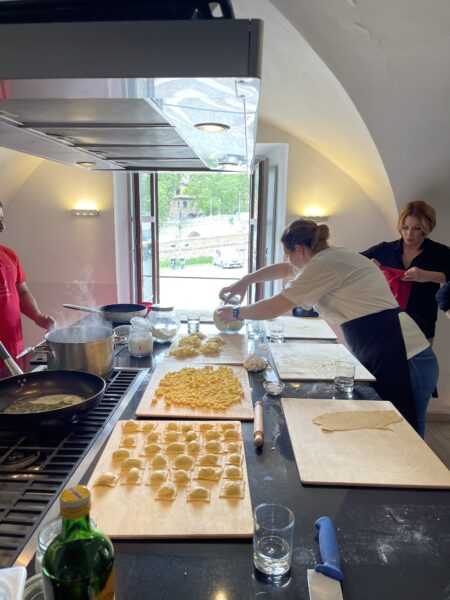
There are two primary sources of Italian flour: soft wheat and durum (hard) wheat. The soft wheat is used to make 0 and 00 flours, while the durum wheat is used to make semolina flour. The durum wheat also has a slightly golden hue, which is why we usually think of semolina as yellow. Since durum wheat is sturdier, it is often used to make pasta that is dried and packaged (as opposed to fresh). But you can also use semolina flour to make the pasta like the cavatelli we made above.
If you’re interested in learning more about Italian and European flour, there’s a ton of info at Pure Flour from Europe. If you’d like to purchase Italian flours, your best bet in the U.S. is an Italian specialty food store. (But look for more coming soon to a store near you!).
Thank You, Pasta Friends
Thank you so much to Pure Flour From Europe and ITALMOPA for the tour and the pasta lessons, and to Chef Fabio and Chef Monica for sharing their wisdom. And another big thanks to my wonderful friends and co-pasta makers Amay Asrani, Stacey Ballis, Dorie Greenspan and Michael Greenspan, and Cara Stewart.
Blogger disclosure: The Pure Flour From Europe campaign sponsored my trip to Italy and the pasta lesson. I did not otherwise receive compensation for this post.

 Hi! I'm Jeanne Fratello - a writer, reporter, and food enthusiast who is on a mission to write great stories about food and where your food comes from.
Hi! I'm Jeanne Fratello - a writer, reporter, and food enthusiast who is on a mission to write great stories about food and where your food comes from.
No comments yet.